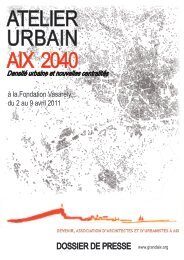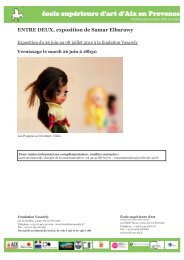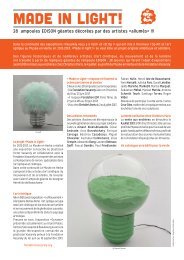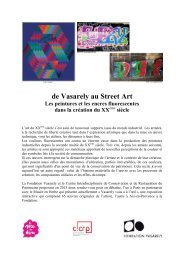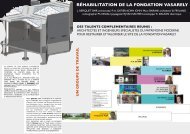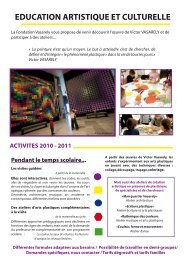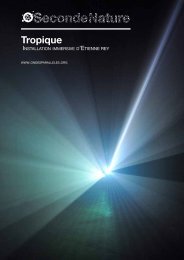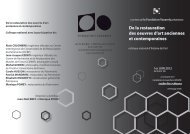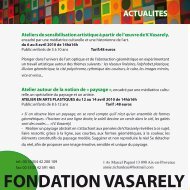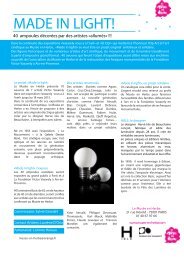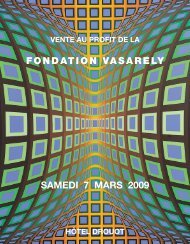Victor Vasarely - Fondation Vasarely
Victor Vasarely - Fondation Vasarely
Victor Vasarely - Fondation Vasarely
Create successful ePaper yourself
Turn your PDF publications into a flip-book with our unique Google optimized e-Paper software.
80<br />
1951 – 1955 Worked on an extensive series of works<br />
entitled ‘Noir et Blanc’ (black and white). Created<br />
‘Photographismes,’ large-scale photographic enlargements<br />
of black and white drawings, alongside kinetic images made<br />
up of superimposed acrylic glass panes. Developed and<br />
defined the visual elements of Op art, the movement with<br />
which his name had become inextricably linked. In 1955<br />
published his Yellow Manifesto and received the Critics<br />
Award in Brussels and the Gold Medal at the Milan Triennial.<br />
Completed a series of murals for the University of Caracas<br />
in Venezuela, as well as several architectural integrations<br />
such as Hommage à Malevitch. Initiated a (now legendary)<br />
group exhibition at Galerie Denise René (1955) entitled ‘Le<br />
Mouvement’ (the motion). In addition to Marcel Duchamp,<br />
Alexander Calder and <strong>Vasarely</strong>, the exhibition included<br />
works by Yaacov Agam, Pol Bury, Jesús Rafael Soto, Yaakov<br />
Agam and Jean Tinguely, and provided a framework and<br />
impetus for the artists who were laying the foundations of<br />
Kinetic Art. Moved to Arcueil.<br />
1955 – 1965 Completed ‘Folklore Planétaire’ (interstellar<br />
folklore) and his ‘Permutations’ series. ‘Unité Plastique’<br />
(pictorial unit) is patented. In the mid 1960’s <strong>Vasarely</strong><br />
explored the two and three dimensions of the octagon,<br />
through the Bidim, Hexagon, Vega, Tridim and Line cycles of<br />
work. Participated in numerous exhibitions such as, ‘50 Ans<br />
d’Art Moderne’ at the Palais International des Beaux-Arts,<br />
Brussels (1958): the ‘Inaugural Selection’ at the Solomon R.<br />
Guggenheim Museum, New York (1959): ‘Documenta III’ in<br />
Kassel, Germany (1964), and most notably, ‘The Responsive<br />
Eye’ at the Museum of Modern Art, New York (1965).<br />
Received the International Guggenheim Award in New York<br />
(1964): the Grand Prix de la Gravure in Ljubljana (1965), as<br />
well as, the Grand Prize at the VIII Art Biennale of São Paolo<br />
(1965). Also awarded the Chevalier de l’Ordre des Arts et<br />
Lettres (1965). Moved to Annet-Sur-Marne.<br />
1966 – 1969 Accomplished several architectural projects,<br />
including one for the French pavilion at the World Expo in<br />
Montreal (1967). Numerous group exhibitions, among them<br />
‘Lumière et Mouvement’ (light and motion) at the Musée<br />
d’Art Moderne de la Ville, Paris (1967): ‘10 Ans d’Art vivant<br />
(1955-65)’ at the <strong>Fondation</strong> Maeght, Saint Paul-de-Vence<br />
(1968). Solo exhibitions at the Sidney Janis Gallery, New York<br />
(1966 and 1968): Galerie Denise René, Paris (1969), and the<br />
Museum of Fine Arts, Budapest (1969).<br />
1970 – 1975 Inauguration of the <strong>Vasarely</strong> Museum in Gordes<br />
(1970). Developed architectural integrations and educational<br />
programmes, initially for the Museum in Gordes, later<br />
linked to the <strong>Vasarely</strong> Foundations in America, Germany<br />
and Norway. The <strong>Vasarely</strong> Foundation is recognised by<br />
the French State in 1971 as a “fondation reconnue d’utilité<br />
publique”. Published four volumes of ‘Plasti-cité’ and<br />
received the International Art Book Award for two of these<br />
volumes in 1971 and 1975. Solo exhibitions at the Galerie<br />
Denise René (1972) and Sidney Jannis Gallery (1972).<br />
Designed the set for the Racine Opera Bérenice, performed<br />
in Hungary.<br />
1976 - 1982 Inauguration of the <strong>Vasarely</strong> Museum in his<br />
hometown of Pécs (1976). Opened architecture centre as<br />
part of the <strong>Vasarely</strong> Foundation Aix–en–Provence (1976),<br />
which offered one possible solution for the synthesis of<br />
art and architecture, and additionally was an international<br />
studio for analytical visual experimentation. Held solo<br />
exhibitions at the Caracas Museum of Contemporary Art<br />
(1977), and the Phoenix Art Museum (1979). Created 154<br />
prints that were transported into space by cosmonaut Jean-<br />
Loup Chrétien onboard the French-Soviet mission ‘Soyuz 7.’<br />
These works are later sold for the benefit of UNESCO.<br />
1983 – 90 <strong>Vasarely</strong> is named an Honorary Citizen of the<br />
City of New York, Officier de l’Ordre des Arts et des Lettres<br />
(1985) and promoted to the rank of Grand Officier de l’Ordre<br />
du Mérite in France (1990). Inauguration of the <strong>Vasarely</strong><br />
Museum at the Zichy Palace in Budapest, Hungary (1987).<br />
His wife Klára Spinner dies.<br />
1996 <strong>Vasarely</strong> Museum closes in Gordes.<br />
1997 <strong>Vasarely</strong> dies in Paris, March 15, just shy of his 91st<br />
birthday.



